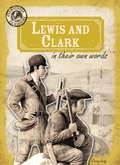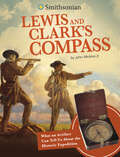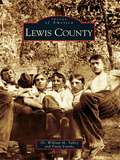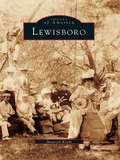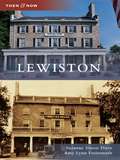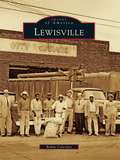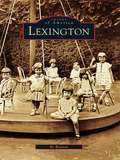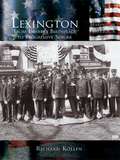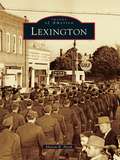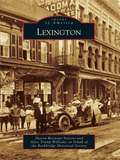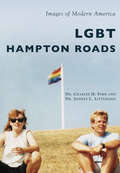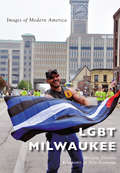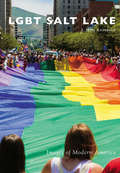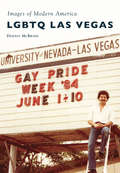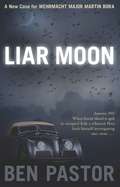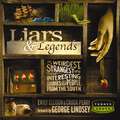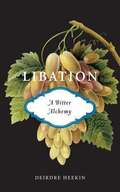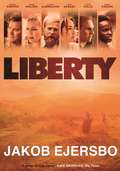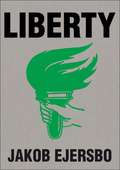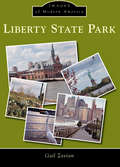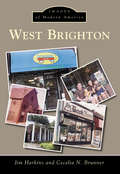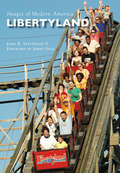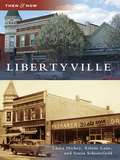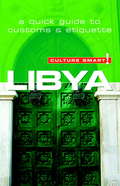- Table View
- List View
Lewis And Clark In Their Own Words
by Janey LevyThe journey of Meriwether Lewis and William Clark across the newly acquired Louisiana Territory from 1804 to 1806 was truly extraordinary. It's best explained using the journals of these two explorers. In this book, primary source materials were carefully chosen to highlight the most interesting and exciting parts of the adventure. An Eyewitness to History book.
Lewis and Clark’s Compass: What an Artifact Can Tell Us About the Historic Expedition (Artifacts from the American Past)
by John Micklos Jr.The Louisiana Purchase in 1803 nearly doubled the size of the United States. The U.S. suddenly went from consisting of 17 states along the Atlantic coast to claiming land as far west as present-day Montana. The U.S. government knew little about the terrain there. Was there a water route to the Pacific? President Thomas Jefferson sent William Clark and Meriwether Lewis to find out. With nothing to guide them but a compass, what would Lewis and Clark discover? Readers will find the answer to this question and how an artifact can tell us about U.S. history.
Lewis County (Images of America)
by Paula Franke Dr William TalleyLewis County, located in far northeastern Kentucky, was formed in 1806 and named for explorer Meriwether Lewis. The county was once teeming with industry as a supplier of finished goods and agricultural products. Historically, the county's proximity to the Ohio River allowed the export oftimber and salt, and in the 1800s, railroad transportation made Lewis County an influential source of railroad ties, boat-building materials, and barrels. In later years, the area was most popular for its health resorts, spas, and "sulfur waters," which attracted visitors from as far as New York and Chicago. The images in this volume depict the county's military influence, as Lewis Countians had strong allegiance to the Union during the Civil War. The photographs featured in Images of America: Lewis County have been drawn from the archive of the Vanceburg DepotMuseum and from various private collections.
Lewisboro
by Maureen KoehlThe history of a town is found in the faces of its people and the places familiar to them. It is the story of the families that lived, worked, and played together over the years. With Lewisboro, the reader is invited to take a fascinating step back in time to view the history of this Westchester County town as it unfolds. The town is divided into six hamlets that are each proud of their unique heritage: Vista, Lewisboro, South Salem, Waccabuc, Cross River, and Goldens Bridge. Primarily a rural farm community in the nineteenth and early twentieth centuries, the introduction of the New York City Reservoir System and improved highways changed Lewisboro in many ways. Its lakes became lake communities offering affordable vacation homes; its farms became neighborhoods; and the railroad made commuting a way of life. Slowly the town grew.
Lewiston
by Amy Lynn Freiermuth Suzanne Simon DietzLewiston, New York, a village and town on the mighty Niagara River, was destroyed during the War of 1812. Rebuilding began in the embers from that war, and the ongoing transformation has created a popular tourist destination for music, theater, festivals, and more. Historian Suzanne Simon Dietz and photographer Amy Lynn Freiermuth combined their talents to create Lewiston by selecting images from local museums, libraries, newspaper archives, and private collections.
Lewisville (Images of America)
by Robin Cole-JettOriginally known as Holford's Prairie, Lewisville's name is not the only thing that has changed about this town in its long history. Settlers sponsored by the Peters Colony Company founded the small community in the 1840s. In the ensuing years, the settlement, renamed to Lewisville by Basdeal W. Lewis in 1856, consistently grew and prospered until its incorporation in 1925. Cotton farming and ginning, the arrival of the Dallas and Wichita Railroad in 1881, the expansion of Lake Dallas into Lake Lewisville in 1954, and the opening of the Dallas/Fort Worth International Airport in 1974 ensured that Lewisville became an important commercial center in booming North Texas. Throughout its phenomenal growth, however, Lewisville still retained the charm and bonds of its farm-centered past. Today Lewisville boasts the largest population and school district in Denton County and serves as a suburb for the bustling Dallas/Fort Worth Metroplex.
Lexington
by Bo BennettLexington, North Carolina, heralded as the "Barbecue Capital of the World," is located in the heart of the Triad, just 30 miles from High Point, Winston-Salem, and Greensboro. Along with barbecue, the town enjoys a rich history in the furniture business and textile industry. Legend claims that the European families who made Lexington their home in the early 1700s named it after a battle of the American Revolution. On April 19, 1775, the brave soldiers of Lexington, Massachusetts, armed themselves and courageously fought the British, losing seven American lives. News of their courage reached North Carolina, and it was decided to name the town in honor of the place whereone of the first known British resistances occurred.
Lexington: From Liberty's Birthplace to Progressive Suburb
by Richard KollenA quiet colonial town forever changed by the shot heard 'round the world on April 19, 1775, Lexington evolved from its famous roots and adapted to the ever-changing culture of the nation it helped create. Over the centuries, an influx of immigrants and new ideas helped shape the town from farming community to booming rail suburb and into today's diverse city that treasures its rich heritage while striving toward a dynamic future.
Lexington
by Sharon R. PaethOriginally known as Saxe Gotha Township when it was created by the Colonial government in 1735, Lexington has a unique and rich history. The county began simply as a buffer between the city of Charleston and the Native Americans. Creative locals built a thriving business community in the area around the Congaree River in present-day Cayce, supporting trade between the colonists and the Native Americans. Emigrants from Germany and Switzerland were invited to become pioneers. They were independent, hard-working farmers who built the area into a strong and sustaining home despite numerous trials and tribulations. Native American wars, fires, Civil War, depressions, and world wars only solidified these settlers' strong sense of ownership and pride in their county. Today visitors enjoy over 50 historical sites and recreation facilities.
Lexington
by Rockbridge Historical Society Sharon Ritenour Stevens Alice Trump WilliamsLexington, the seat for Rockbridge County, is situated in the beautiful Shenandoah Valley within minutes of the Blue Ridge Mountains. Main Street is part of Route 11--the Valley Pike/Great Road--and the architecture downtown looks much as it did in the 19th century. Lexington is home to Washington and Lee University and Virginia Military Institute. It is also the final resting place for Thomas "Stonewall" Jackson and Robert E. Lee, as well as their horses. Within a few blocks, one visits the Stonewall Jackson House, Lee Chapel Museum, the VMI Museum, and the George C. Marshall Library Museum.
LGBT Hampton Roads (Images of Modern America)
by Dr Jeffrey Littlejohn Dr Charles FordVirginia's Hampton Roads region has long attracted diverse and mobile people, some of whom embraced same-sex love or fluid gender identities long before lesbian, gay, bisexual, and transgender (LGBT) communities identified as such. By the mid-1900s, Hampton Roads would lead the state in its development of LGBT institutions and infrastructure. Our Own Press would chronicle the extraordinary burst of creativity and activism that seemed to place LGBT developments in the region on a national stage. In the late 1980s and 1990s, however, military crackdowns and the HIV/AIDS epidemic devastated the leadership of local LGBT communities. Only in the new century would there be a renaissance of networking and engagement to bring the annual Pride Festival to center stage at Town Point Park in Norfolk.
LGBT Milwaukee (Images of Modern America)
by Don Schwamb Michail TakachOver the past 75 years, gays and lesbians have experienced tremendous social change in America. Gay and lesbian culture, once considered a twilight world that could not be spoken of in daylight, has become today's rainbow families, marriage equality victories, and record-breaking pride celebrations. For a medium-size Rust Belt city with German Protestant roots, Milwaukee was an unlikely place for gay and lesbian culture to bloom before the Stonewall Riots. However, Milwaukee eventually had as many--if not more--known LGBT+ gathering places as Minneapolis or Chicago, ranging from the back rooms of the 1960s to the video bars of the 1980s to the guerrilla gay bars of today.
LGBT Salt Lake (Images of Modern America)
by J. Seth AndersonSalt Lake City, located along Utah’s majestic Wasatch Mountains, has historically been a cradle of peculiar people. Before Western culture developed terms for lesbian, gay, bisexual, or transgender (LGBT) identities, diverse communities who recognized their differences from mainstream America made Salt Lake their home. By the early 1970s, a discernible “gay community” had emerged in Salt Lake City, laying the groundwork for future activism and institutions. In the 1970s, publications like Gayzette, the Salt Lick, and the Open Door documented the nascent movement. In the 1980s, amidst devastation from the HIV/AIDS epidemic, marginalized communities valiantly worked to fight the disease and support each other. By the 1990s, LGBT Utahns had gained traction legally and politically with the formation of the first gay straight alliance at East High School and the election of the first openly gay person to the Utah legislature in 1998. The transgender community became more visible in the new century, and by 2008, Utah began to play a prominent role in the battle over marriage equality.
LGBTQ Las Vegas
by Dennis McbrideLas Vegas is known around the world as a flashy, libertarian oasis where an individual�s pursuit of happiness and profit is paramount. This was not true for the city�s queer community. Being gay in Las Vegas until the 1990s was a felony with a hefty fine and long prison sentence. The Las Vegas LGBTQ community did not organize to fight for its rights until the late 1970s and by the early 1980s had made significant headway, before AIDS stopped their momentum. While the plague was devastating, it taught compassion, self-reliance, and political savvy. In 1993, the community persuaded the Nevada State Legislature to repeal the state�s sodomy law, and throughout the 1990s and 2000s�even with some significant setbacks�Las Vegas rapidly caught up with more enlightened places in the United States. By 2017, Las Vegas was a city among the most welcoming of the nation�s queer community.
Liar Moon
by Ben PastorPraise for Ben Pastor's Lumen: "Pastor's plot is well crafted, her prose sharp. . . . A disturbing mix of detection and reflection."--Publishers Weekly "Rivets the reader with its twist of historical realities. A historical piece, it faithfully reproduces the grim canvas of war. A character study, it captures the thoughts and actions of real people, not stereotypes."--The Free Lance-Star "And don't miss Lumen by Ben Pastor. . . . An interesting, original, and melancholy tale."--Literary Review Italy, September 1943. The Italian government switches sides and declares war on Germany. The north of Italy is controlled by the fascist puppets of Germany; the south liberated by Allied forces fighting their way up the peninsula. Having survived hell on the Russian front, Wehrmacht major and aristocrat Baron Martin von Bora is sent to Verona. He is ordered to investigate the murder of a prominent local fascist: a bizarre death threatening to discredit the regime's public image. The prime suspect is the victim's twenty-eight-year-old widow Clara. Haunted by his record of opposition to SS policies in Russia, Bora must watch his step. Against the backdrop of relentless anti-partisan warfare and the tragedy of the Holocaust, a breathless chase begins. Ben Pastor, born and now back in Italy, lived for thirty years in the United States, working as a university professor in Vermont. The first in the Martin Bora series, Lumen, was published by Bitter Lemon Press in May 2011.
Liars & Legends: The Weirdest, Strangest, and Most Interesting Stories from the South
by Emily EllisonEveryone loves a good story. And Liars and Legends contains 40 of the South's most interesting and . . . well . . . just plain curious stories. This book grows out of the popular Turner South television show, Liars and Legends and will be promoted on the show.
Libation
by Deirdre HeekinFor many years, Deirdre Heekin has been creating an unusual, revitalist wine archive of rare and traditional Italian varietals at Osteria Pane e Salute, the nationally celebrated restaurant and wine bar she shares with her chef husband, Caleb Barber. Self-taught in the world of Italian wines, she is known for her fine-tuned work with scent and taste and her ability to pair wines and food in unexpected yet terroir-driven ways. InLibation, a Bitter Alchemy,, a series of linked personal essays, Heekin explores the curious development of her nose and palate, her intuitive education and relationship with wine and spirits, and her arduous attempts to make liqueurs and wine from the fruits of her own land in northern New England. The essays follow her as she unearths ruby-toned wines given up by the ghosts of long-gone wine makers from the red soil of Italy, her adoptive land; as she embarks on a complicated pilgrimage to the home of one of the world's oldest cocktails, Sazerac, in Katrina-soaked New Orleans; as she attempts a midsummer crafting of a brandy made from inherited roses, the results of an old Sicilian recipe she found in a dusty bookstore in Naples. Musing on spirits from Campari to alkermes, Heekin's writing is as intoxicating, rich, and carefully crafted as the wines, liquors, and locales she loves.
Liberty (The Africa Trilogy)
by Jakob EjersboThe novel behind the new Danish TV series starring The Killing's Sofie Gråbøl, available on All 4 / Walter PresentsTwo young men from very different backgrounds. Christian is the son of Danish ex-pats; Marcus works as a house boy for a Swedish family, hoping they will eventually take him back to Europe with them. Their friendship defines a divided continent. When they decide to go into business together - a teenage dream of playing at discos - they unwittingly set a collision course. But will it be love or money that tears the two apart? Spanning a decade from the dawn of the 1980s, the story of Marcus and Christian's dissolving friendship plays out amid a vast cast of characters, all fighting to make their way in a country defined by corruption. As the Tanzanian authorities and European aid agencies compete to line their own pockets, the rise of 'the disease' threatens to lay waste to an already stricken continent.
Liberty
by Jakob EjersboTwo young men from very different backgrounds.Christian is the son of Danish ex-pats; Marcus works as a house boy for a Swedish family, hoping they will eventually take him back to Europe with them.Their friendship defines a divided continent.When they decide to go into business together--a teenage dream of playing at discos--they unwittingly set a collision course. But will it be love or money that tears the two apart?Spanning a decade from the dawn of the 1980s, the story of Marcus and Christian's dissolving friendship plays out amid a vast cast of characters, all fighting to make their way in a country defined by corruption. As the Tanzanian authorities and European aid agencies compete to line their own pockets, the rise of 'the disease' threatens to lay waste to an already stricken continent.
Liberty
by Jakob EjersboThe novel behind the new Danish TV series starring The Killing's Sofie Gråbøl, available on All 4 / Walter PresentsTwo young men from very different backgrounds.Christian is the son of Danish ex-pats; Marcus works as a house boy for a Swedish family, hoping they will eventually take him back to Europe with them. Their friendship defines a divided continent.When they decide to go into business together - a teenage dream of playing at discos - they unwittingly set a collision course. But will it be love or money that tears the two apart? Spanning a decade from the dawn of the 1980s, the story of Marcus and Christian's dissolving friendship plays out amid a vast cast of characters, all fighting to make their way in a country defined by corruption. As the Tanzanian authorities and European aid agencies compete to line their own pockets, the rise of 'the disease' threatens to lay waste to an already stricken continent.
Liberty State Park (Images of Modern America)
by Gail ZavianSituated on the Hudson River, the Central Railroad of New Jersey terminal operated its railroad/maritime complex for over 100 years in this area. After its shutdown in 1967, community advocates, already lobbying for nine years, continued their successful campaign for the site to become a public park. With over 1,000 acres, Liberty State Park opened on Flag Day--June 14, 1976. Today, this recreational landscape features the Nature Interpretive Center, Liberty Science Center, and a section of the Hudson River Waterfront Walkway. Liberty State Park, in Jersey City, is the only place in New Jersey where one can board a ferry to visit Ellis Island and the Statue of Liberty. Liberty State Park showcases the rich cultural and environmental history of this landscape's transformation from an abandoned waterfront transportation hub into one of America's most exceptional state parks.
Liberty State Park (Images of Modern America)
by Gail ZavianSituated on the Hudson River, the Central Railroad of New Jersey terminal operated its railroad/maritime complex for over 100 years in this area. After its shutdown in 1967, community advocates, already lobbying for nine years, continued their successful campaign for the site to become a public park. With over 1,000 acres, Liberty State Park opened on Flag Day--June 14, 1976. Today, this recreational landscape features the Nature Interpretive Center, Liberty Science Center, and a section of the Hudson River Waterfront Walkway. Liberty State Park, in Jersey City, is the only place in New Jersey where one can board a ferry to visit Ellis Island and the Statue of Liberty. Liberty State Park showcases the rich cultural and environmental history of this landscape's transformation from an abandoned waterfront transportation hub into one of America's most exceptional state parks.
Libertyland (Images of Modern America)
by John R. V Jimmy OgleNestled in the heart of Memphis, Tennessee, the Libertyland theme park debuted on America�s bicentennial: July 4, 1976. The quaint park celebrated America�s history, heritage, and culture. Not only was it home to Elvis Presley�s favorite roller coaster, Libertyland also offered guests rides on the historic Grand Carousel, exciting shows, gift shops selling handcrafted souvenirs, delicious food, and much more. The park�s themed areas�Colonial Land, Frontier Land, and Turn-of-the-Century Land�paid tribute to some of the country�s most historically significant eras. From its opening in 1976 until its closure in late 2005, Libertyland was a first roller coaster ride, a first date, a family reunion, a summer job, or simply a reprieve from the hustle and bustle of the real world.
Libertyville
by Sonia M. Schoenfield Laura Hickey Arlene F. LaneA turning point for Libertyville came in the 1950s. The town was growing up, transitioning from a quaint farming community into a vibrant upper-middle class suburban village. Carl Cizek documented this change in a series of photographs. Recaptured today, the images offer a visual journey of a maturing town. .
Libya - Culture Smart!
by Roger JonesCulture Smart! provides essential information on attitudes, beliefs and behavior in different countries, ensuring that you arrive at your destination aware of basic manners, common courtesies, and sensitive issues. These concise guides tell you what to expect, how to behave, and how to establish a rapport with your hosts. This inside knowledge will enable you to steer clear of embarrassing gaffes and mistakes, feel confident in unfamiliar situations, and develop trust, friendships, and successful business relationships.Culture Smart! offers illuminating insights into the culture and society of a particular country. It will help you to turn your visit-whether on business or for pleasure-into a memorable and enriching experience. Contents include* customs, values, and traditions* historical, religious, and political background* life at home* leisure, social, and cultural life* eating and drinking* dos, don'ts, and taboos* business practices* communication, spoken and unspoken"Culture Smart has come to the rescue of hapless travellers." Sunday Times Travel"... the perfect introduction to the weird, wonderful and downright odd quirks and customs of various countries." Global Travel"...full of fascinating-as well as common-sense-tips to help you avoid embarrassing faux pas." Observer"...as useful as they are entertaining." Easyjet Magazine"...offer glimpses into the psyche of a faraway world." New York Times
